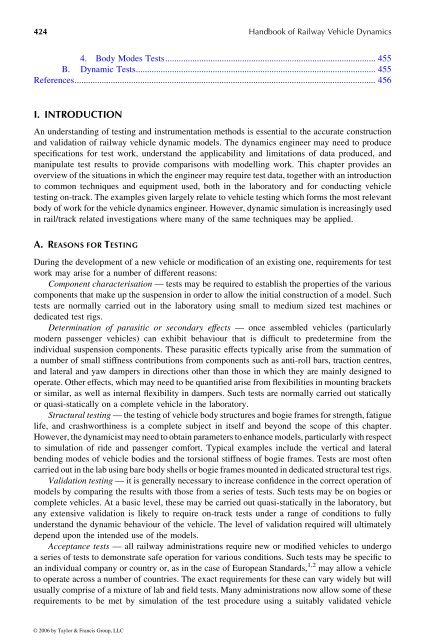Create successful ePaper yourself
Turn your PDF publications into a flip-book with our unique Google optimized e-Paper software.
424<br />
4. Body Modes Tests............................................................................................. 455<br />
B. Dynamic Tests.......................................................................................................... 455<br />
References..................................................................................................................................... 456<br />
I. INTRODUCTION<br />
An understanding <strong>of</strong>testing and instrumentation methods is essential to the accurate construction<br />
and validation <strong>of</strong> railway vehicle dynamic models. The dynamics engineer may need to produce<br />
specifications for test work, understand the applicability and limitations <strong>of</strong> data produced, and<br />
manipulate test results to provide comparisons with modelling work. This chapter provides an<br />
overview <strong>of</strong> the situations in which the engineer may require test data, together with an introduction<br />
to common techniques and equipment used, both in the laboratory and for conducting vehicle<br />
testing on-track. The examples given largely relate to vehicle testing which forms the most relevant<br />
body <strong>of</strong> work for the vehicle dynamics engineer. However, dynamic simulation is increasingly used<br />
in rail/track related investigations where many <strong>of</strong> the same techniques may be applied.<br />
A. R EASONS FOR T ESTING<br />
<strong>Handbook</strong> <strong>of</strong> <strong>Railway</strong> <strong>Vehicle</strong> <strong>Dynamics</strong><br />
During the development <strong>of</strong> anew vehicle or modification <strong>of</strong> an existing one, requirements for test<br />
work may arise for anumber <strong>of</strong> different reasons:<br />
Component characterisation —tests may be required toestablish the properties <strong>of</strong> the various<br />
components that makeupthe suspension in order to allow the initial construction <strong>of</strong> amodel. Such<br />
tests are normally carried out in the laboratory using small to medium sized test machines or<br />
dedicated test rigs.<br />
Determination <strong>of</strong> parasitic or secondary effects —once assembled vehicles (particularly<br />
modern passenger vehicles) can exhibit behaviour that is difficult to predetermine from the<br />
individual suspension components. These parasitic effects typically arise from the summation <strong>of</strong><br />
anumber <strong>of</strong> small stiffness contributions from components such as anti-roll bars, traction centres,<br />
and lateral and yaw dampers in directions other than those in which they are mainly designed to<br />
operate. Other effects, which may need to be quantifiedarise from flexibilities in mounting brackets<br />
or similar, as well as internal flexibility in dampers. Such tests are normally carried out statically<br />
or quasi-statically on acomplete vehicle in the laboratory.<br />
Structural testing —the testing <strong>of</strong> vehicle body structures and bogie frames for strength, fatigue<br />
life, and crashworthiness isacomplete subject in itself and beyond the scope <strong>of</strong> this chapter.<br />
However, the dynamicist may need to obtain parameters to enhance models, particularly with respect<br />
to simulation <strong>of</strong> ride and passenger comfort. Typical examples include the vertical and lateral<br />
bending modes <strong>of</strong> vehicle bodies and the torsional stiffness <strong>of</strong> bogie frames. Tests are most <strong>of</strong>ten<br />
carriedout in the lab usingbare body shells or bogie frames mounted in dedicated structural testrigs.<br />
Validation testing —itisgenerally necessary to increase confidence in the correct operation <strong>of</strong><br />
models by comparing the results with those from aseries <strong>of</strong> tests. Such tests may be on bogies or<br />
complete vehicles. At abasic level, these may be carried out quasi-statically in the laboratory, but<br />
any extensive validation is likely torequire on-track tests under arange <strong>of</strong> conditions to fully<br />
understand the dynamic behaviour <strong>of</strong> the vehicle. The level <strong>of</strong>validation required will ultimately<br />
depend upon the intended use <strong>of</strong> the models.<br />
Acceptance tests —all railway administrations require new or modified vehicles to undergo<br />
aseries <strong>of</strong> tests to demonstrate safe operation for various conditions. Such tests may be specific to<br />
an individual company or country or, as in the case <strong>of</strong> European Standards, 1,2 may allow avehicle<br />
to operate across anumber <strong>of</strong> countries. The exact requirements for these can vary widely but will<br />
usually comprise <strong>of</strong> amixture <strong>of</strong> lab and field tests. Many administrations now allow some <strong>of</strong> these<br />
requirements to be met by simulation <strong>of</strong> the test procedure using asuitably validated vehicle<br />
© 2006 by Taylor & Francis Group, LLC









